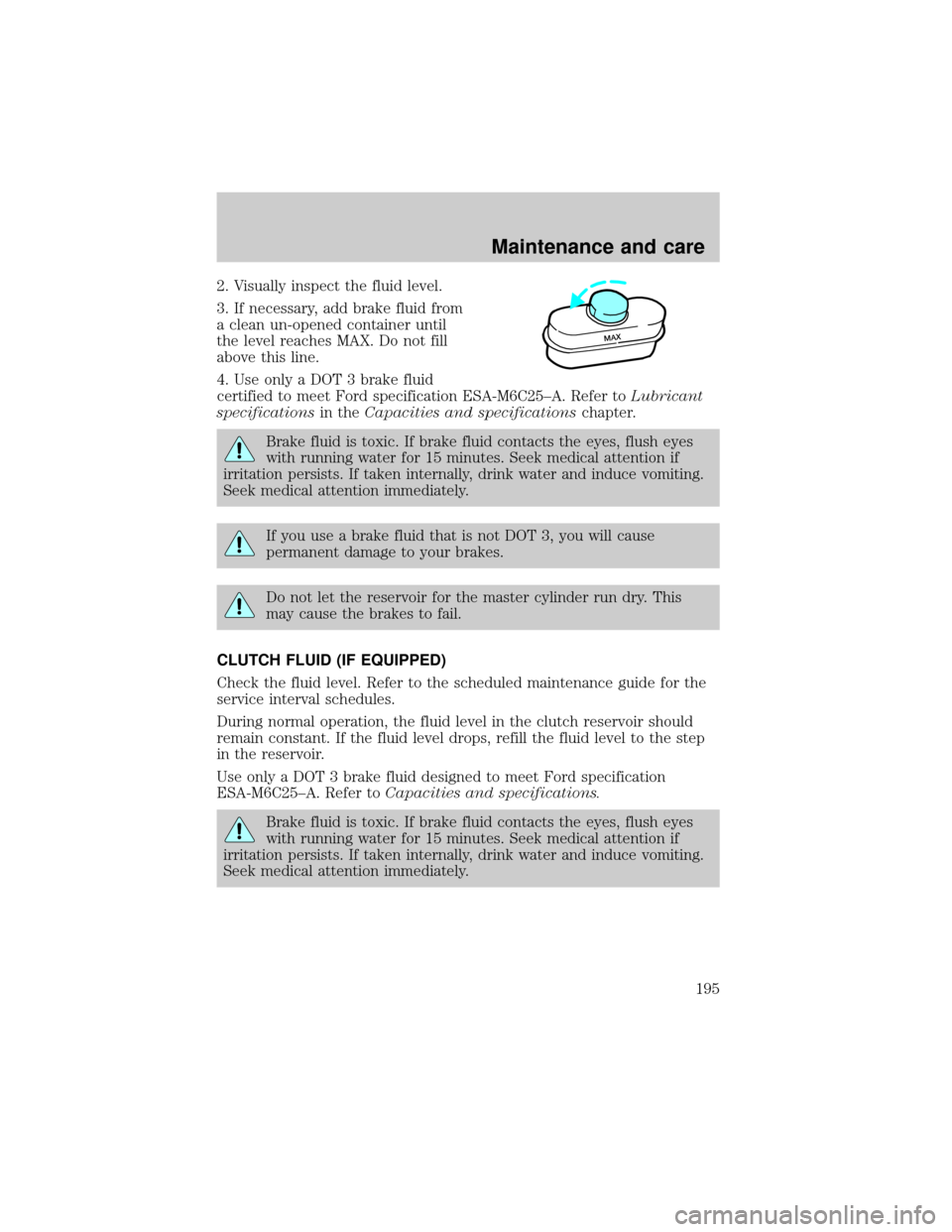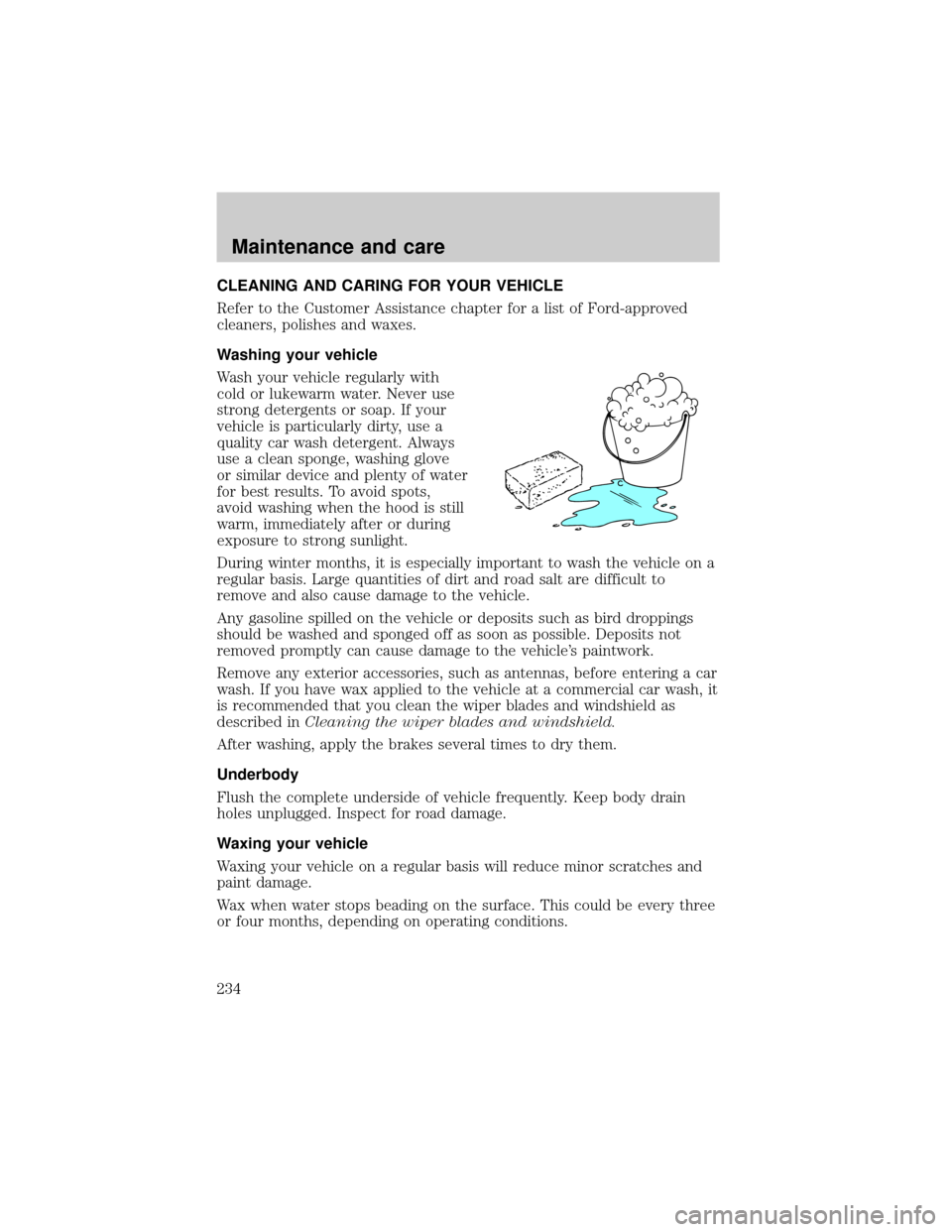2001 FORD RANGER brakes
[x] Cancel search: brakesPage 144 of 272

TRACTION-LOK AXLE (IF EQUIPPED)
This axle provides added traction on slippery surfaces, particularly when
one wheel is on a poor traction surface. Under normal conditions, the
Traction-Lok axle functions like a standard rear axle.
Extended use of other than the manufacturer's specified size tires on a
Traction-Lok rear axle could result in a permanent reduction in
effectiveness. This loss of effectiveness does not affect normal driving
and should not be noticeable to the driver.
To avoid injury, never run the engine with one wheel off the
ground, such as when changing a tire.
DRIVING THROUGH WATER
Do not drive quickly through standing water, especially if the depth is
unknown. Traction or brake capability may be limited and if the ignition
system gets wet, your engine may stall. Water may also enter your
engine's air intake and severely damage your engine.
If driving through deep or standing water is unavoidable, proceed very
slowly. Never drive through water that is higher than the bottom of the
hubs (for trucks) or the bottom of the wheel rims (for cars).
Once through the water, always try the brakes. Wet brakes do not stop
the vehicle as effectively as dry brakes. Drying can be improved by
moving your vehicle slowly while applying light pressure on the brake
pedal.
Driving through deep water where the transmission vent tube is
submerged may allow water into the transmission and cause
internal transmission damage.
VEHICLE LOADING
Before loading a vehicle, familiarize yourself with the following terms:
²Base Curb Weight:Weight of the vehicle including any standard
equipment, fluids, lubricants, etc. It does not include occupants or
aftermarket equipment.
²Payload:Combined maximum allowable weight of cargo, occupants
and optional equipment. The payload equals the gross vehicle weight
rating minus base curb weight.
Driving
144
Page 147 of 272

3. Subtract your loaded vehicle weight from the maximum GCWR on the
following charts. This is the maximum trailer weight your vehicle can tow
and must fall below the maximum shown under maximum trailer weight
on the chart.
TRAILER TOWING
Your vehicle may tow a class I, II or III trailer provided the maximum
trailer weight is less than or equal to the maximum trailer weight listed
for your engine and rear axle ratio on the following charts.
Your vehicle's load capacity is designated by weight, not by volume, so
you cannot necessarily use all available space when loading a vehicle.
Towing a trailer places an additional load on your vehicle's engine,
transmission, axle, brakes, tires and suspension. Inspect these
components carefully after any towing operation.
4x2 w/manual transmission
Engine Rear
axle
ratioMaximum
GCWR - kg
(lbs.)Maximum
trailer
weight - kg
(lbs.)Maximum
frontal
area of
trailer -
m
2(ft2)
Regular Cab w/6' box
2.3L All 2 177 (4 800) 753 (1 660) Equal to
frontal area
of vehicle
3.0L
(non-torsion bar
suspension)All 2 722 (6 000) 1 207 (2 660) 4.64 (50)
3.0L (torsion
bar suspension)All 2 722 (6 000) 1 152 (2 540) 4.64 (50)
4.0L
(non-torsion bar
suspension)All 3 175 (7 000) 1 624 (3 580) 4.64 (50)
4.0L (torsion
bar suspension)All 3 175 (7 000) 1 569 (3 460) 4.64 (50)
Driving
147
Page 153 of 272

Preparing to tow
Use the proper equipment for towing a trailer, and make sure it is
properly attached to your vehicle. See your dealer or a reliable trailer
dealer if you require assistance.
Hitches
For towing trailers up to 907 kg (2 000 lb), use a weight carrying hitch
and ball which uniformly distributes the trailer tongue loads through the
underbody structure. Use a frame-mounted weight distributing hitch for
trailers over 907 kg (2 000 lb).
Do not install a single or multi-clamp type bumper hitch, or a hitch
which attaches to the axle. Underbody mounted hitches are acceptable if
they are installed properly. Follow the towing instructions of a reputable
rental agency.
Whenever a trailer hitch and hardware are removed, make sure all
mounting holes in the underbody are properly sealed to prevent noxious
gases or water from entering.
Safety chains
Always connect the trailer's safety chains to the frame or hook retainers
of the vehicle hitch. To connect the trailer's safety chains, cross the
chains under the trailer tongue and allow slack for turning corners.
If you use a rental trailer, follow the instructions that the rental agency
gives to you.
Do not attach safety chains to the bumper.
Trailer brakes
Electric brakes and manual, automatic or surge-type trailer brakes are
safe if installed properly and adjusted to the manufacturer's
specifications. The trailer brakes must meet local and Federal
regulations.
Do not connect a trailer's hydraulic brake system directly to your
vehicle's brake system. Your vehicle may not have enough
braking power and your chances of having a collision greatly increase.
The braking system of the tow vehicle is rated for operation at the
GVWR not GCWR.
Driving
153
Page 195 of 272

2. Visually inspect the fluid level.
3. If necessary, add brake fluid from
a clean un-opened container until
the level reaches MAX. Do not fill
above this line.
4. Use only a DOT 3 brake fluid
certified to meet Ford specification ESA-M6C25±A. Refer toLubricant
specificationsin theCapacities and specificationschapter.
Brake fluid is toxic. If brake fluid contacts the eyes, flush eyes
with running water for 15 minutes. Seek medical attention if
irritation persists. If taken internally, drink water and induce vomiting.
Seek medical attention immediately.
If you use a brake fluid that is not DOT 3, you will cause
permanent damage to your brakes.
Do not let the reservoir for the master cylinder run dry. This
may cause the brakes to fail.
CLUTCH FLUID (IF EQUIPPED)
Check the fluid level. Refer to the scheduled maintenance guide for the
service interval schedules.
During normal operation, the fluid level in the clutch reservoir should
remain constant. If the fluid level drops, refill the fluid level to the step
in the reservoir.
Use only a DOT 3 brake fluid designed to meet Ford specification
ESA-M6C25±A. Refer toCapacities and specifications.
Brake fluid is toxic. If brake fluid contacts the eyes, flush eyes
with running water for 15 minutes. Seek medical attention if
irritation persists. If taken internally, drink water and induce vomiting.
Seek medical attention immediately.
MAX
Maintenance and care
195
Page 234 of 272

CLEANING AND CARING FOR YOUR VEHICLE
Refer to the Customer Assistance chapter for a list of Ford-approved
cleaners, polishes and waxes.
Washing your vehicle
Wash your vehicle regularly with
cold or lukewarm water. Never use
strong detergents or soap. If your
vehicle is particularly dirty, use a
quality car wash detergent. Always
use a clean sponge, washing glove
or similar device and plenty of water
for best results. To avoid spots,
avoid washing when the hood is still
warm, immediately after or during
exposure to strong sunlight.
During winter months, it is especially important to wash the vehicle on a
regular basis. Large quantities of dirt and road salt are difficult to
remove and also cause damage to the vehicle.
Any gasoline spilled on the vehicle or deposits such as bird droppings
should be washed and sponged off as soon as possible. Deposits not
removed promptly can cause damage to the vehicle's paintwork.
Remove any exterior accessories, such as antennas, before entering a car
wash. If you have wax applied to the vehicle at a commercial car wash, it
is recommended that you clean the wiper blades and windshield as
described inCleaning the wiper blades and windshield.
After washing, apply the brakes several times to dry them.
Underbody
Flush the complete underside of vehicle frequently. Keep body drain
holes unplugged. Inspect for road damage.
Waxing your vehicle
Waxing your vehicle on a regular basis will reduce minor scratches and
paint damage.
Wax when water stops beading on the surface. This could be every three
or four months, depending on operating conditions.
Maintenance and care
234
Page 263 of 272

A
Air bag supplemental restraint
system ........................................103
and child safety seats ............105
description ..............................103
disposal ....................................107
driver air bag ..........................105
indicator light ...................12, 107
operation .................................105
passenger air bag ...................105
passenger deactivation
switch ................................29, 108
Air cleaner filter .......................240
Air conditioning ..........................22
manual heating and air
conditioning system .................24
Ambulance packages ....................5
Antifreeze (see Engine
coolant) .....................................197
Anti-lock brake system (see
Brakes) ......................................128
Anti-theft system
warning light .............................13
Audio system (see Radio) ...29, 49
Automatic transmission ............132
driving an automatic
overdrive .................................133
fluid, adding ............................203
fluid, checking ........................203
fluid, refill capacities ..............240
fluid, specification ..................245
Auxiliary power point ...........28, 73
Axle
lubricant specifications...243, 245
refill capacities ........................240
traction lok ..............................144B
Battery .......................................207
acid, treating emergencies .....207
charging system
warning light .............................13
jumping a disabled battery ....178
maintenance-free ....................207
replacement, specifications ...240
servicing ..................................207
voltage gauge ............................19
Bed extender ..............................74
Belt minder .................................99
Brakes ........................................128
anti-lock ...................................128
anti-lock brake system (ABS)
warning light .....................13, 129
brake warning light ..................12
fluid, checking and adding ....194
fluid, refill capacities ..............240
fluid, specifications .........243, 245
lubricant specifications ..243, 245
parking ....................................129
shift interlock ..........................132
Break-in period .............................3
C
Capacities for refilling fluids ....240
Cargo area shade ........................74
Cargo net .....................................74
Certification Label ....................248
Child safety restraints ..............113
child safety belts ....................113
Child safety seats ......................114
attaching with tether straps ..118
in front seat ............................115
in rear seat ..............................115
Index
263
Page 266 of 272

H
Hazard flashers .........................159
Headlamps ...................................20
aiming ......................................233
bulb specifications ..................232
daytime running lights .............20
flash to pass ..............................21
high beam ...........................13, 21
replacing bulbs .......................227
turning on and off ....................20
warning chime ..........................15
Heating ........................................22
heater only system ...................22
Hood ..........................................185
I
Ignition .........................65, 245±246
Infant seats
(see Safety seats) .....................114
Inspection/maintenance (I/M)
testing ........................................226
Instrument panel
cleaning ...................................238
cluster ................................10, 238
lighting up panel and
interior .......................................21
location of components ............10
J
Jack ............................................171
positioning .......................171, 175
storage .....................171±173, 175
Jump-starting your vehicle ......178K
Keys .......................................85±87
key in ignition chime ...............15
positions of the ignition ...........65
L
Lamps
bulb replacement
specifications chart ................232
cargo lamps ...............................21
daytime running light ...............20
fog lamps ...................................20
headlamps .................................20
headlamps, flash to pass ..........21
instrument panel, dimming .....21
interior lamps ...................71, 233
replacing bulbs .......227, 229±232
Lane change indicator (see
Turn signal) .................................64
Lights, warning and indicator ....10
air bag ........................................12
anti-lock brakes (ABS) ....13, 129
anti-theft ...................................13
brake ..........................................12
charging system ........................13
check coolant ............................12
check engine .............................10
cruise indicator .........................15
door ajar ....................................14
fuel cap light .............................11
high beam .................................13
overdrive off ..............................14
safety belt .................................12
speed control ............................69
turn signal indicator .................13
Load limits .................................144
GAWR ......................................144
GVWR ......................................144
Index
266